Any conventional machining or metal cutting operation needs a wedge shaped sharp edged cutting tool in order to remove excess material from the workpiece to obtain desired shape, size, finish and tolerance. For removing material from workpiece two relative motions (apart from the depth of cut) between the workpiece and cutting tool are indispensable. These are cutting motion and the feed motion. These motions can be imparted either on cutting tool or workpiece or on both.
In case of turning operation, carried out on lathe, cutting tool (called single point turning tool—SPTT) is mounted on tool post and the entire tool post moves by various mechanical arrangements to provide necessary feed motion. Since the tool carriage can move both—left and right directions, so it is necessary to preset the cutting tool on the tool post based on desired direction of movement.
For two different directions, two different tools are required, and accordingly SPTT can be classified into two categories—right handed cutting tool and left handed cutting tool. Note that the concept of left hand and right hand tools is commonly applicable for single point cutters (like lathe and boring tools). For cutters having helix shape (such as drills, end mills, etc.), usually left hand helix or right hand helix concept is considered to provide direction of rotation (clockwise or counterclockwise).
Right handed cutting tool
A right handed cutting tool, the common one, can remove material while moving leftward (take only top view keeping rake surface at top). The name is derived from its analogy with human right hand. As shown in the picture, the thumb direction represents the tool feed direction. Thus principal cutting edge of the tool must be at left side of the tool, as shown below.

Left Handed Cutting Tool
Opposite to the right handed cutting tool, a left handed cutting tool can remove material while moving rightward (here also take only top view keeping rake surface visible). The name is derived from its analogy with human left hand as the left hand thumb direction indicates the tool feed direction. So the principal cutting edge should also be at the right side.

References
- Book: Geometry of Single-point Turning Tools and Drills – Fundamentals and Practical Applications by V. P. Astakhov.
- Book: Machining and Machine Tools by A. B. Chattopadhyay.